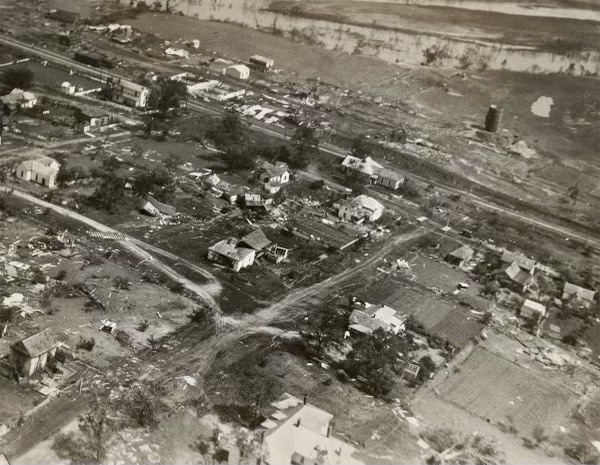A series of events that began around March 30th of 1927 would alter the history of Arkansas, Imboden was not spared in the event.
This photo of the City of Imboden was taken shortly after the flood of 1927 and shows the widespread devastation throughout the town.
The flood of 1927 was the most destructive and costly flood in the history of the State of Arkansas and one of the worst in the history of the nation.
The 1927 flood afflicted Arkansas with horrific devastation, both human and monetary. The flood had social and political ramifications which changed the way Arkansas viewed relief from natural disasters and the responsibility of government in aiding the victims.
Let’s set the stage, the spring of 1927 brought warm weather and early snow melts to regions in Canada, causing the upper Mississippi to swell.
The upper Midwest had large rainfalls sending its full rivers flowing into the already swollen Mississippi. The runoff’s destination, the Gulf of Mexico, acted as a stopper when it too became full. Then, in the South, it began to rain.
Timeline of events:
March 30, 1927
Laconia Circle Levee breaks. (Desha County)
April 4, 1927
St. Francis River reaches record stage at Marked Tree.
April 5, 1927
Three men shot during attempt to blow up a levee near Marked Tree.
April 11, 1927
Record rise at Big Lake threatens Pettyville, Manila, and Monette.
April 12, 1927
Ferry service on White River at Batesville was suspended because of high water.
April 13, 1927
Three levee breaks were reported in Crawford County.
April 15, 1927
Fourche Levee east of Little Rock breaks.
April 16, 1927
Eight more levees break in Arkansas.
April 19, 1927
Levee break near New Madrid, Missouri, sends water into Arkansas.
April 20, 1927
Levee at Clarendon breaks. Nearly the entire town is submerged in less than ten minutes.
April 20, 1927
Levee at Pendleton breaks. An estimated 500 people marooned on bridge near Pine Bluff.
April 22, 1927
2,000 refugees stranded on crumbling 2 1/2 feet wide levee at Knowlton’s Landing near Helena. People and livestock are stretched out along the levee for three miles with no shelter and little food.
April 24, 1927
Arkansas City was under five feet of water. 500 people homeless.
April 25, 1927
McGehee was inundated by flood waters. 3,000 refugees were in the city at the time. Approximately half of them were evacuated to Monticello by train shortly thereafter.
April 26, 1927
Pine Bluff made patrol base of the Arkansas Air National Guard. The 154th Observation Squadron was transferred to the city by a special troop train.
April 27, 1927
Lake Village was covered by twelve feet of water. McGehee is placed under martial law.
April 28, 1927
Eudora made refugee center. 1,800 people are camped on a peninsula surrounded by flood waters.
April 29, 1927
South Bend, last major levee on the Arkansas River, breaks.
American Red Cross’ response was described as quick to the disaster with emergency workers arriving by trains, trucks, and automobiles.
Fifty refugee camps were originally built in Arkansas by the Red Cross, with one in Forrest City holding an estimated 15,000 homeless.
Victims kept arriving from all around Arkansas— described as cold, sick, and hungry.
Homeless found shelter in public buildings or other makeshift locations. All found themselves without food, water, or dry clothing.
Segregated tent cities along the high ground could barely hold the homeless and displaced, disease reportedly ran rampant in the overcrowded makeshift camps.
More facts about the 1927 Flood:
An estimated 6,600 square miles in Arkansas were covered by flood water affecting some 36 of Arkansas’ 75 counties. Water was reported to be 30 feet deep in some places. In Arkansas some 350,000 people were affected by flood waters. Over 2 million acres of farmland was damaged or destroyed.
The Red Cross set up 154 refugee camps throughout Arkansas before the event ended, the camps were in use until mid- September 1927. (Photo below shows the Red Cross camp in Jonesboro Arkansas during the Flood of 1927)
Some 41,000 families received monetary assistance after the disaster.
Although the “official death toll” of the event was reported to be 127 in Arkansas, many researchers believe the numbers to be even higher.
The Mississippi River was above flood stage in 1927 for 153 days.
Presidential Candidate Herbert Hoover (Secretary Of Commerce at the time of the disaster) called the Flood of 1927 “America’s Greatest Peacetime Disaster”.


